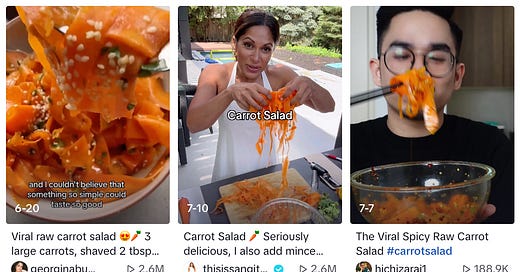3 TikTok 'Health' Trends, Explained
Full disclosure: I’m not even on TikTok. Not yet at least. I admittedly spend way too much time scrolling through Instagram already. I fear joining TikTok will take my ‘Weekly Screen Time Report’ to unsettling heights.
I still catch wind of ‘health’ trends circulating on TikTok, so I thought I’d give a dietitian’s take on a few of them.
I hope most of the below seems fundamentally obvious. Still, I think we could all use the friendly reminder that genetically blessed, un-credentialed 19-year-olds on the interweb probably aren’t the best source of medical information.
3 TikTok Health Fads, Explained —
01: Raw carrot salad
The claim: Shaved carrot salads have gained tons of attention for their supposed ability to “balance hormones.” Take this viral video that has 2.4 million views and reports that the salad (usually made from a combo of ingredients like raw shredded carrots, olive oil, apple cider vinegar, and sea salt) is great for “detoxifying excess estrogen, getting rid of stubborn belly fat, and for balancing and maintaining good gut bacteria.”
The reality: If only it were that easy. It’s true that increasing your dietary fiber intake can support hormone health. This is in part because eating more fiber can help you have more regular bowel movements. Since the body gets rid of excess hormones via the stool, increasing the amount of plant foods in your diet may be helpful for people who struggle with symptoms with high estrogen (such as heavy periods, premenstrual headaches, mood swings, and cyclic breast tenderness).
Eating more prebiotic-rich plant foods is also helpful for increasing microbial diversity in the gut. Nothing bogus there.
But don’t count on a carrot salad melting away 'stubborn belly fat.’ Above all, fat loss requires consistent resistance training and adequate protein intake.
P.S. —> I wrote for an article for Well+Good all about why products and recipes that claim to ‘balance hormones’ are actually BS. Give it a read HERE for experts’ insights on the trending topic.
02: The ‘internal shower’
The claim: Search ‘internal shower drink’ on TikTok and you’ll find some 258 million views of videos on the topic. The buzzy beverage contains water, two tablespoons of chia seeds, and a squeeze of fresh lemon juice. The simple combo is said to act as an all-natural treatment for constipation.
The reality: I don’t hate this! Adequate hydration is key for regular bowel movements (BMs), so drinking more water will be helpful for digestion even if it’s consumed on its own.
Chia seeds are a stellar source of soluble fiber. If you’ve ever seen chia seed pudding (or made this internal shower drink yourself), you’ve seen their soluble properties in action: they quickly plump up due to the fact that they can absorb lots of water. This is exactly what makes them so helpful for digestion. Chia seeds’ soluble fiber forms a gel in the GI tract that helps hydrate and soften stool.
As for the lemon juice in here, there’s nothing magical about it.
The bottom line? This beverage is not a magic bullet, but I have no problem with people trying it. It’s also a solid option for travel, when digestion tends to get thrown off. I often tell clients to pack a small baggy of chia seeds to add to hotel breakfasts, but you could also just dump a couple of spoonfuls into your water bottle for a quick dose of fluid and fiber.
03: Cottage cheese and mustard —
The claim: Cottage cheese is a diet culture darling. Meal plans like the Atkins, South Beach, and Scarsdale diets all allowed for the high-protein ingredient. More recently, TikTok has exploded with recipes that incorporate cottage cheese, from faux ice cream to pasta sauces, bagels, dips, and whips. Also, pancakes, waffles, and pizza toasts. The list goes on.
The hype mostly has to do with the fact that cottage cheese is high in protein, a key macronutrient for weight management and muscle mass synthesis.
The newest viral combo? Cottage cheese mixed with mustard. The pairing comes from a TikTok user who eats the two ingredients together daily and claims it has assisted in her 80-pound weight loss journey. You can find her posting (borderline obscene?) videos of herself dipping foods like chicken sausage, carrots, and hearts of palm into the condiment combo. And now thousands of others are following suit.
The reality: There’s nothing inherently dangerous about this combination, apart from its high sodium content. This isn’t a huge deal for most people, but if you’re watching your salt intake for health reasons, know that cottage cheese and mustard are both rich in sodium. Dip a chicken sausage into them and you’re looking at a serious salt bomb.
Here’s what’s even more concerning to me than the salt content: leaning heavily on condiments is actually a sign of disordered eating behaviors. People struggling with anorexia nervosa, for example, may use condiments in two ways.
The first is to provide zero-calorie flavor to otherwise boring foods. This might look like dipping copious amounts of raw celery into mustard and calling it a meal or snack.
On the flip side, some people struggling with deep food fears tend to add a ton of condiments to their meals in the hopes that it will taste bad and therefore prevent them from overeating.
Both behaviors are problematic. And to me, the cottage cheese and mustard craze only normalizes them.
Hungry for more? Schedule a free intro call here if you’re interested in working together and subscribe to the free ALIVE+WELL Nutrition newsletter for health wisdom you can actually use.






